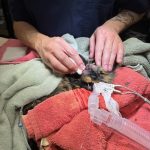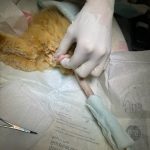During the summer my cat Higgins (Higgy) was lying at the top of the stairs and I noticed that she was lethargic, she’d lost a little bit of weight. After monitoring her for a day or two I noticed that she was unable to poop and she winced when I touched her stomach. To cut a long story short, she ended up being hospitalized for two days for an impacted colon. She’s been doing very well until a few days ago. We’ve been giving her lactulose, as prescribed by our vet and we’ve also given her a little Catlax. Her appetite is the same, I’ve been giving her only wet food, she’s drinking water like she normally would and, she is urinating plus, her weight is the same. Her behavior is normal, she’s playing and she’s already attacked the Christmas tree, but she hasn’t been to the bathroom for 5 days. Any advice would be appreciated.
Comments
My little dog Angel (14 yo shin tzu/ Lhasa Apso mix) went to the vet on November 28 due to stumbling , possible blood in stool, and weight loss. The vet said she had no blood in her stool and was diagnosed with intestinal parasites. She was prescribed metronidazole, Regan, and Pepcid. Prior to her starting the medication she was walking but slipping on her hind legs. Also prior to the medication she was eating and drinking water. As the days went by she started dragging her hind legs. I did research and found your videos on the beagel with IVDD. So yesterday December 3rd we took her to a second vet and explained everything that was going on with Angel as well as showing the vet the medications Angel was taking. According to the vet from yesterday the dose was too large for her 7.4 lb frame that she could have developed some neurotoxicity. However the vet said since she was having some difficulty walking prior to the medication then it was more likely IVDD. We were told she was too far along and would require surgery. I ask about oral medications to treat her IVDD and then we were told she was in renal failure. So due to her renal insufficiency and possible upper GI bleed they are unable to give prednisone to help with the inflammation. Angel’s lab work showed an elevated BUN/Creat and she is acidotic. I ask about IV fluids to resolve the renal insufficiency and the vet said we could do IV fluids for 24-48 hours which may only give her a 50/50 chance of renal improvement. The vet then went on to say even if we corrected her renal function she would still have the issue of IVDD and with her dark stools Angel would still not be able to take the prednisone. The final option the vet suggested was euthanasia.
She said we could take Angel home with gabapentin, sucralfate, mirtazapine, and cerenia. Just spend time with her and love on her with an life expectancy of about 2 days.
At this point I’m at a loss because it seemed everything snowballed very quickly.
Today December 4 my adult kids are coming to see her and my husband said we need to take her in for euthanasia on Tuesday December 5th. I feel like I’m giving up on her. The vet said her prognosis is poor and even with surgery she may never have a good quality of life.
Any advice would be appreciated.
Thank you




































Hello,
In cases like this I try to teach people how to palpate their cat so they can monitor the size of the colon. This will help you understand and take care of the feces before it becomes obstipation.
In some cases there is an underlying problem that causes poor movement of the colon. I also recommend lots of exercise and bloodwork to look for other possible conditions like kidney disease or thyroid disease that might be complicating the condition.
Thank you for responding. She had blood work done and all was good with her kidneys. I’ll give her another day and if there’s no change I’ll take her back to the vet.